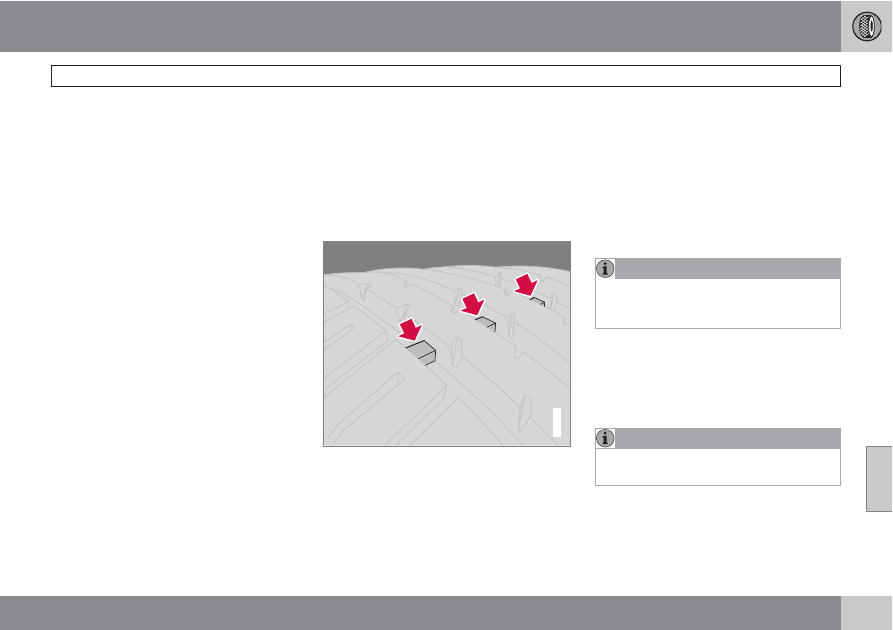Volvo V50 (2012 year). Instruction - part 11

07 Wheels and tyres
General
07
195
The reason for this is that tyres age and decom-
pose, even if they are hardly ever or never used.
The function can therefore be affected due to
the tyre's constituent materials being broken
down. In such a case the tyre should then not
be used. This also applies to spare tyres, winter
tyres and tyres saved for future use. Examples
of external signs which indicate that the tyre is
unsuitable for use are cracks or discoloration.
The age of the tyre can be determined by the
DOT marking, see previous illustration.
More even wear and maintenance
The correct tyre pressure results in more even
wear, see page 198. Driving style, tyre pres-
sure, climate and road condition affect how
quickly your tyres age and wear. To avoid dif-
ferences in tread depth and to prevent wear
patterns arising, the front and rear wheels can
be switched with each other. A suitable dis-
tance for the first change is approx. 5000 km
and then at 10 000 km intervals. Volvo recom-
mends that you contact an authorised Volvo
workshop for checking if you are uncertain
about tread depth. If significant differences in
wear (>1 mm difference in tread depth)
between tyres have already occurred, the least
worn tyres must always be placed on the rear.
Understeer is normally easier to correct than
oversteer, and leads to the car continuing for-
wards in a straight line rather than having the
rear end skidding to one side, resulting in pos-
sible complete loss of control over the car. This
is why it is important for the rear wheels never
to lose grip before the front wheels.
Wheels should be stored lying down or hanging
up, and not standing up.
Tyres with tread wear indicators
G020323
Tread wear indicators.
Tread wear indicators are narrow treadless
bands across the width of the tread. On the
side of the tyre are the letters TWI (Tread Wear
Indicator). When the tyre's tread depth is down
to 1.6 mm, the tread depth will be level in height
with the tread wear indicators. Change to new
tyres as soon as possible. Remember that
tyres with little tread depth provide very poor
grip in rain and snow.
Winter tyres
Volvo recommends winter tyres with specific
winter tyre dimensions. Tyre dimensions are
dependent on engine variant. When driving on
winter tyres, they must be fitted to all four
wheels.
NOTE
Volvo recommends that you consult a Volvo
dealer about which wheel rim and tyre types
are most suitable.
Studded tyres
Studded winter tyres should be run in gently for
500-1000 km, so that the studs settle properly
into the tyres. This gives the tyre, and espe-
cially the studs, a longer service life.
NOTE
The legal provisions for the use of studded
tyres vary from country to country.
Tread depth
Road conditions with ice, slush and low tem-
peratures place considerably higher demands
on tyres than summer conditions. It is therefore